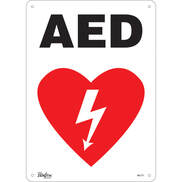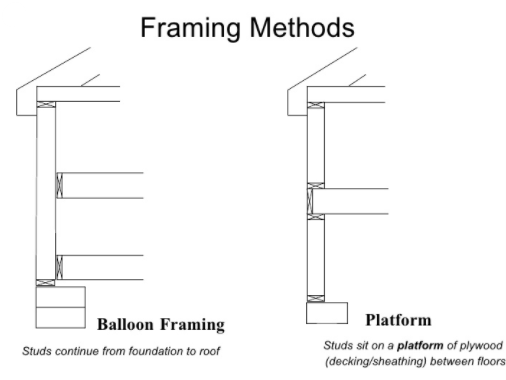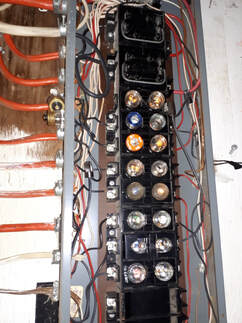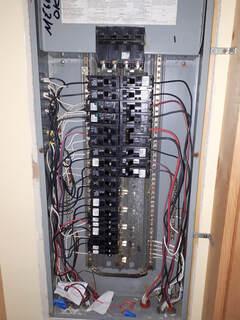Mike's Home Inspector BlogMichael Burfitt |
|
I was recently looking through my blog archives and noticed I have nothing written on building framing. This is no coincidence: I have seen a lot of home issues but generally do not run across problems with framing. Homes are built using clear building codes and my concerns are usually limited to looking for signs of DIY structural repairs after the home is built. This is especially a concern to me when I see the large number of TV shows promoting “open concept” homes and making it look as simple as swinging a sledgehammer and hauling off the old building materials, but I digress. There are a number of ways homes can potentially be framed with wood but there are two main types in North America: balloon framing and platform framing. What is the difference between the two and why does it matter? The simple answer is that balloon framing goes directly from the foundation up to the roof with the floors put in later while platform framing is built one floor at a time, in other words, each floor is independent of each other. While balloon framing was the most common construction method up until the 1940s, it has been almost completely replaced with platform framing. There are a number of reasons for this:
As an inspector, I am most concerned about the last point. One of the main drawbacks of balloon framing is that it does not have a fire separation between floors. The main reason balloon framing went out of style is because a fire can travel quickly in the wall cavity, and this has caused a series of devastating house fires that spread rapidly from basements to bedrooms. That’s not to say balloon framing is automatically bad: they have better wind and shrinkage resistance and there are no joints in the exterior studs and while expensive, fire protection can be added. Unfortunately, this is not something most home inspectors can verify as we do not engage in destructive or invasive inspections (both types look identical on a finished home) but is something to keep in mind. As a general rule of thumb, a house that is less than 70 years old is likely made with platform framing and anything over 80 years old is almost certainly constructed with balloon framing.  This is a perfect example of a roof covering that needs replacement. This is a perfect example of a roof covering that needs replacement. There are few things that I consider more important than providing outstanding home inspections: operating my business in a safe, legal, and ethical manner is one of them. I am extensively trained and experienced in working from heights thanks to my career in building operations and know how dangerous and difficult working at elevations can be. While there are some variables and subjectivity involved, such as snow or rain, there is no need to be subjective about what is considered a safe roof height to traverse: Nova Scotia’s laws prescribe the regulations involved in working from heights without a proper fall arrest system. Workplace Health and Safety Regulations - Occupational Health and Safety Act (Nova Scotia) You are welcome to try and read the entire set of regulations without falling asleep but all you need to know is that you can only work up to 10' (3m) from a safe surface without having a fall arrest system. While such residential fall arrest systems do exist, they are expensive and used almost exclusively by roofing companies. So, how do we inspect the roof if it cannot be traversed safely or legally? There are a number of alternatives. The easiest such way is to inspect from the eaves while remaining on the ladder. Often times I can easily inspect from the ladder as I have developed a sixth sense if the roof has an issue and know what to look for. This is my preferred method but is not always feasible, especially on very tall houses. The next alternative, while not my favourite, is to use a pair of binoculars to check the condition of the roof from the ground. UPDATE: As of 2022, I now have a drone (or helicopter as my son likes to call it) to provide a higher quality roof and gutter inspection when it isn't possible to traverse the roof. I did one inspection where there was no way to either reach the roof or see it from the ground. To accomplish this inspection, I got as high as I could and used a pole to attach my camera. The picture I took clearly shows the roof was well past its life expectancy and needed immediate attention. There are also some roofs that cannot be safely stepped on by home inspectors no matter how close they are to the ground. Two such examples are roofs with a metal covering and steep roofs of any kind. I also inspect roofs from the underside by entering the attic space. This is the only way to determine if there are any active roof leaks or evidence of any past leaks: there are a number of indications such as an anomaly on my thermal imager, compressed insulation, organic growth and of course visibly dripping water. This blog makes it clear how passionate I am about sharing my knowledge of home inspections and how much I go the extra mile for my clients but never at the expense of anyone’s safety. If I ever get the temptation to skirt the law or do something I know is unsafe I just remind myself of the person who has to tell my toddler that his Daddy considered getting a slightly better view of a roof as more important than coming home safely at the end of the day. It’s a common horror movie cliché that a fuse blows and needs to be replaced in a dark, cold basement. In reality, however, most of what I and other local inspectors see during inspections are circuit breakers, an example of which is pictured below and looks like a series of light switches. There are two basic types of overcurrent protection: fuses and circuit breakers. If I see fuses in a service panel, I will always advise getting an electrician to evaluate the system and generally recommend it should be replaced with modern panel with circuit breakers. What’s wrong with fuses? There are several concerns:
Fuses Have to Be Replaced While a tripped circuit breaker can simply be switched back on, a fuse must be replaced. This can not only be expensive, but often requires a trip to the hardware store at the most inconvenient time. The flip side of this is that it requires to homeowner to determine why it is happening repeatedly rather than just repeatedly flipping a switch. Unfortunately..... Fuses Are Usually Interchangeable This means that different fuses (such as 15 vs 20 amp) are the same size. The problem with this is that homeowners frequently replace a repeatedly melting fuse with a larger size. While on the surface this solves the problem this is a very dangerous practice, and it allows a circuit to carry more current than can be safely handled which can lead to an electrical fire. Fuse Panels are (Generally) Obsolete If you read my previous blog post on Knob & Tube wire, you would know that K&T is dangerous mainly because of how old it is. Fuses have not been used in homes (except in rare conditions) since the 1970s and nearly all are past their expected lifespan. Insurance Issues Many insurance companies look negatively on a fuse box, mainly for the last two reasons I just stated. While beyond the scope of a home inspection, I have heard plenty of stories of insurers demanding electrical systems be upgraded to a modern circuit breaker as a condition of writing a policy on a home. It’s not as simple as saying fuses = bad and circuit breakers = good. In fact, fuses are better at preventing over currents and, while very reliable, circuit breakers still are not 100% foolproof. Our heat pump (installed in 2020) also uses a fuse for one simple reason: they react much faster to a power surge and can protect the unit from catastrophic damage far better. This is why a home inspector will recommend an electrician: I’ve said it before, and I will say again that electrical systems can be very dangerous and more complicated than they appear.  As a home inspector, I am continuously refining my skills to notice things that the average person may not. Part of my abilities come from my experience as an Advanced Medical First Responder: I used to volunteer with St. John Ambulance at major public events and part of my role was usually to locate and take possession of the AED as I was both extensively trained and experienced in using it. What exactly is an AED? It stands for Automated External Defibrillator and is used to reset a heart that is in a shockable rhythm. They are found in more and more buildings and (hopefully sooner rather than later) will eventually be found in most condominium and apartment complexes and even some homes as the price continues to drop on basic models. Much like home inspections, there are a lot of myths and misconceptions I hear about these units. AEDs Are Only for Trained Personnel (or Doctors) This may have been true in the past but is absolutely, positively FALSE. While I would highly recommend everyone to take a first aid course, these units can be used by anyone (yes, even children), and they will clearly spell out in easy to understand voice prompts how to properly use them for anyone not trained. AEDs Can Cause Unnecessary Pain and Suffering An AED works by analyzing a heart rhythm and if it detects a shockable rhythm (ventricular fibrillation or pulseless ventricular tachycardia) only then will it allow the user to deliver a shock. While I obviously don’t recommend doing so, hooking an AED up to a conscious person or anyone who is not in cardiac arrest will mean you cannot deliver a shock, accidently or otherwise. This myth can be expanded further to include a fear of accidently breaking ribs or causing serious damage to a casualty. To put it bluntly, anyone in cardiac arrest is in immediate life-threatening danger and you only have minutes before irreversible damage is done to the brain so do not be afraid of cutting expensive clothing or potentially breaking bones. There is almost zero potential for legal liability for doing anything in good faith to attempt lifesaving procedures as a bystander, trained or not. An AED will Start a Stopped Heart (or is a Magic Pill) Building on the previous myths, an AED will NOT restart an asystole (AKA flatline) rhythm. Nor will it magically restore someone to life like in a video game. An AED, combined with CPR and calling 911 are only tools that can be used to keep someone alive long enough to get to a hospital. The sad reality is while an AED is a lifesaving piece of equipment, the odds are against anyone in cardiac arrest where seconds count. AEDs are Only for People Having a Heart Attack While a heart attack can lead to cardiac arrest, they are two separate issues (think of it as a plumbing problem vs an electrical problem). One of the reasons we always carried an AED when doing public events was knowing that cardiac arrests happen suddenly and without warning. Whenever I go out and about, I tend to automatically note where the nearest AED, first aid station and fire extinguisher is located. AEDs will eventually be seen nearly everywhere, and it is important to know how to locate one in an emergency. While a cardiac arrest is undoubtedly a scary situation, an AED is straightforward and easy to use without fear by anyone. |
Archives
July 2024
Categories
All
|
|
Inside Edge Home Inspections Ltd.
Halifax, NS 902-209-9921 [email protected] Proudly Serving the HRM & Central Nova Scotia |




 RSS Feed
RSS Feed

